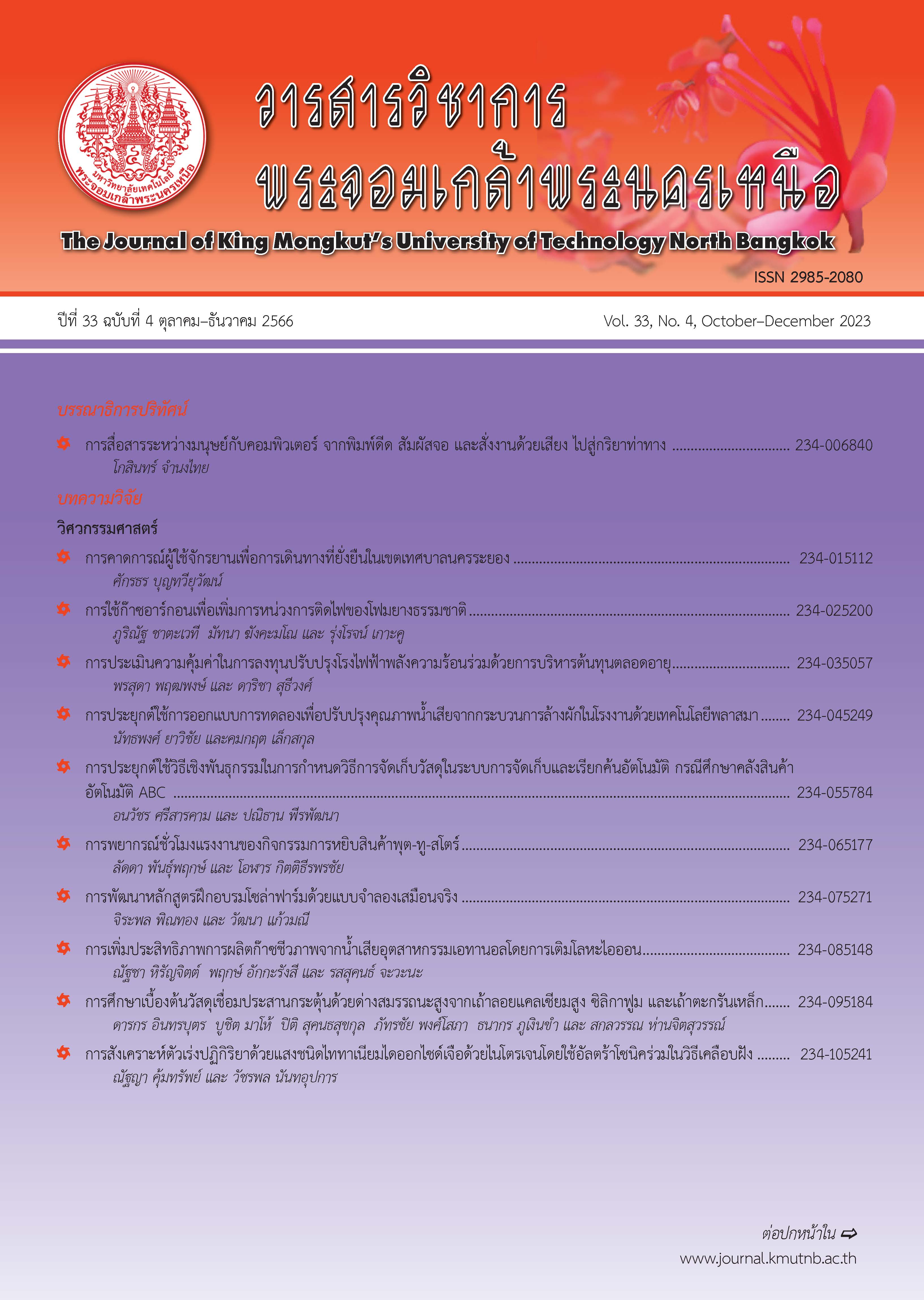Machine Learning-based System for Automatic Morphological Identification of Acanthamoeba spp. in Microscopic Images
Main Article Content
Abstract
Acanthamoeba is free-living protozoa. They are the causative agents of granulomatous encephalitis and keratitis in humans. The simplified morphological identification was based on the shape of the inner and outer wall and the size of the cysts according to the standard criteria, which can be classified into group I, group II, and group III. Although morphology is isolated by the shape and the size of the cysts, it requires expert-skilled explicitly of health promoters. This paper proposes developing an automated machine learning-based system for morphological identification of Acanthamoeba spp. in microscopic images. The system can be separated into three processes, i.e. 1) image preprocessing process, 2) feature descriptors using Histogram of Gradient technique (HOG) as shaped-based approach, and Local Binary Pattern (LBP) as texture-based approach, and 3) SVM-based classification. The proposed approach is evaluated by using our dataset comparing with the state-of-the-art methods. The experimental results show that our proposed method can achieve highly accurate performance superior to the other methods with an accuracy of 89.81%.
Article Details

This work is licensed under a Creative Commons Attribution-NonCommercial-NoDerivatives 4.0 International License.
The articles published are the opinion of the author only. The author is responsible for any legal consequences. That may arise from that article.
References
P. Buppan, C. Meeboon, T. Klamsiri, W. Promyuttana, W. Koamornsup, R. Kosuwin, and P. Srimee, “Survey of Acanthamoeba spp. in water samples from the public park of Thailand,” Journal of Research Unit on Science, Technology and Environment for Learning, vol. 9, no. 1, pp. 36–45, 2018 (in Thai).
C. Suwancharoen and W. Srichoom, “Survey of Acanthamoeba in natural water sources in communities around the university of Phayao, Phayao province, Thailand,” Journal of Public Health, vol. 47, no. 3, pp. 255–263, 2017 (in Thai).
C. Siripanth, “Amphizoic amoebae: Pathogenic free-living protozoa; Review of the literature and review of cases in Thailand,” Journal of the Medical Association of Thailand, vol. 88, no. 5, pp. 1–7, 2005 (in Thai).
C. Bunsuwansakul, T. Mahboob, K. Hounkong, S. Laohaprapanon, S. Chitapornpan, S. Jawjit, A. Yasiri, S. Barusrux, K. Bunluepuech, N. Sawangjaroen, C. C. Salibay, C. Kaewjai, M. L. Pereira, and V. Nissapatorn, “Acanthamoeba in Southeast Asia - overview and challenges,” The Korean Journal of Parasitology, vol. 57, no. 4, pp. 341–357, 2019.
M. Pussard and R. Pons, “Morphologies de la paroi kystique et taxonomie du genre Acanthamoeba (Protozoa, Amoebida),” Protistologica, vol. 13, no. 4, pp. 557–598, 1977.
N. Ruangrungsi and C. Palanuvej, “Acanthamoeba spp. infection's health and risk watch,” Public Health Science, College of Public Health Sciences, Chulalongkorn University, Bangkok, 2011.
J. L. Duarte, C. Furst, D. R. Klisiowicz, G. Klassen, and A. O. Costa, “Morphological, genotypic, and physiological characterization of Acanthamoeba isolates from keratitis patients and the domestic environment in Vitoria, Espirito Santo, Brazil,” Experimental Parasitology, vol. 135, no. 1, pp. 9–14, 2013.
G. C. Booton, G. S. Visvesvara, T. J. Byers, D. J. Kelly, P. A. Fuerst, “Identification and distribution of Acanthamoeba species genotypes associated with nonkeratitis infections,” Journal of Clinical Microbiology, vol. 43, no. 4, pp. 1689–1693, 2005.
J. Rodellar, S. Alférez, A. Acevedo, A. Molina, and A. Merino, “Image processing and machine learning in the morphological analysis of blood cells,” International Journal of Laboratory Hematology, vol. 40, pp. 46–53, 2018.
M. S. Mabrouk, M. A. Sheha, and A. Sharawy, “Automatic detection of melanoma skin cancer using texture analysis,” International Journal of Computer Applications, vol. 42, no. 20, pp. 22–26, 2012.
A. M. Abdeldaim, A. T. Sahlol, M. Elhoseny, and A. E. Hassanien, “Computer-aided acute lymphoblastic leukemia diagnosis system based on image analysis,” Advances in Soft Computing and Machine Learning in Image Processing. vol 730, Springer, Cham, 2018.
A. Vijayalakshmi and B. Rajesh Kanna, “Deep learning approach to detect malaria from microscopic images,” Multimedia Tools and Applications, vol. 79, no. 21–22, pp. 15297–15317, 2019.
T. Ojala, M. Pietikainen, and T. Maenpaa, “Multiresolution gray-scale and rotation invariant texture classification with local binary patterns,” IEEE Transactions on Pattern Analysis and Machine Intelligence, vol. 24, no. 7, pp. 971–987, 2002.
M. K. Hu, “Visual pattern recognition by moment invariants,” RE Transactions on Information Theory, vol. IT-8, no. 2, pp. 179–187, 1962.
J. Canny, “A computational approach to edge detection,” IEEE Transactions on Pattern Analysis and Machine Intelligence, vol. PAMI-8, no. 6, pp. 679–698, 1986.
N. Dalal and B. Triggs, “Histograms of oriented gradients for human detection,” IEEE Computer Society Conference on Computer Vision and Pattern Recognition (CVPR'05), 2005, pp. 886–893.
H. Lahiani and M. Neji, “Hand gesture recognition method based on HOG-LBP features for mobile devices,” Procedia Computer Science, vol. 126, pp. 254–263, 2018.
X. Wang, T. X. Han, and S. Yan, “An HOG-LBP human detector with partial occlusion handling,” in 2009 IEEE 12th International Conference on Computer Vision, 2009, pp. 32–39.
M. Sokolova and G. Lapalme, “A systematic analysis of performance measures for classification tasks,” Information Processing & Management, vol. 45, pp. 427–437, 2009.
T. S. Furey, N. Cristianini, N. Duffy, D. W. Bednarski, M. Schummer, and D. Haussler, “Support vector machine classification and validation of cancer tissue samples using microarray expression data,” Bioinformatics, vol. 16, no. 10, pp. 906–914, 2000.
S. Öztürk and B. Akdemir, “Application of feature extraction and classification methods for histopathological image using GLCM, LBP, LBGLCM, GLRLM and SFTA,” Procedia Computer Science, vol. 132, pp. 40–46, 2018.

